Amidst coronavirus, I’m sticking to what I – and a lot of other people – love most: cooking and baking. One challenge I’ve presented to myself is to make a dish (or dishes) of international cuisines every week, learn some words from the language, and e-visit some of the country’s landmarks. Some of these dishes will be more complex than others, based on what ingredients I have available in the house.

Halo! This week, I was flipping through an old cookbook and came across the recipe for rugelach. That’s when I decided off to Poland I would go!
Polish cuisine shares similarities with its neighboring countries of Germany, Czech Republic, Austria, and Hungary. In general, Polish food is hearty and heavy, with meat often taking center stage. For example, gołąbki is cabbage leaves cooked and filled with rice, sautéed onions, and ground meat. Perhaps one of the most famous dishes from Poland are pierogis, a type of potato-filled dumpling. Other contributions include sernik, a drier version of American Cheesecake, and szarlotka, an apple meringue crumb cake.
DISH #1: CHOCOLATE HAZELNUT RUGELACH (V)
Rugelach (pronounced roo-guh-laak) actually mean “little twists” in Yiddish. Rugelach vary in shape, from crescents, similar to a croissant, to rolls. In Poland, rugelach can be made with sour cream or a cream cheese-based dough, although pareve versions skip the dairy entirely.

Rugelach are filled with a variety of different fillings: raisins, cinnamon, marzipan, poppy seed, homemade jam, and more. My favorite? Using my homemade chocolate hazelnut spread.

These rugelach are fluffy, flakey and decadent pastry bites. They’re easier to make than their French counterpart, pain au chocolat, but still make an impression.

USEFUL WORDS
Greetings
- Cześć –> Hello
- Jak się masz? –> How are you?
- I’m good
- Na razie –> See you later
- Do widzenia –> Goodbye
Conversation
- Co lubisz robić? –> What do you like to do?
- Lubię … –> I like to…
- tańczyć –> dance
- gotować –> cook
- biegać –> run
- Lubię … –> I like to…
- Chciałbym… –> I would like
- Proszę –> Please
- Nie ma za co –> You’re welcome
- Dziękuję Ci –> Thank you
Slang
- Spoko –> No problem, don’t worry
- Git –> Cool
- Mega –> Wow
- Bez kitu –> Seriously?
DISH #2: BAJGIEL (GF + DF)
When I was baking my brezeln for Germany, I snuck in a couple bajgiel (bagels) using the same mix: Rorie’s Original Gluten Free Dough Mix. (I forgot to take a picture of them!) My first job was working at a gluten-free bakery and making the bagels was my main task. I’d roll over 150 bagels, set them in the refrigerator to rise over two days, boil them, and then bake them. It was definitely a time-consuming project (well worth it!), but using this mix only requires the baking-in-the-oven step (major time saver).
According to theatlantic.com, in the 14th century, “[pretzels] were making their way out of their original home in the monasteries and being made into readily available feast day bread.” German immigrants brought pretzels to Poland, where they eventually evolved into obwarzanek, a round roll with a hole in the middle. Obwarzanek was generally eaten by the rich, since most Poles could not afford white wheat. During this era, Jewish people were banned from baking bread because the Church thought that they would threaten the holy Christian connection between bread, Jesus, and the sacrament. At some point, Jewish Poles were allowed to work with bread that was boiled, and began making bagels.
LANDMARKS
Łazienki Park, Warsaw

This park is the largest of its kind in Poland. It’s known as the Palace on the Island, and houses a theater, monument, and more.
Museum of the History of Polish Jews, Warsaw

The POLIN Museum of the History of Polish Jews sits on the site of a former Warsaw Ghetto. In Hebrew, the word “polio” means either “Poland” or “rest here”.
The Cloth Hall, Kraków

Functioning since the Renaissance, the Cloth Hall is one of the central features of Kraków. While its main floor still has vendors, its upper floor now houses an art museum.
Morskie Oko, Tatra Mountains

Morskie Oko, otherwise known as Eye of the Sea in English, is a beautiful, deep lake in Southern Poland.